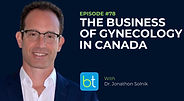BackTable / OBGYN / Podcast / Episode #36
Laparoscopic Hysterectomy Tips & Tricks
with Dr. Mark Hoffman and Dr. Amy Park
In this episode, host Dr. Amy Park interviews co-host Dr. Mark Hoffman about laparoscopic hysterectomies.
Be part of the conversation. Put your sponsored messaging on this episode. Learn how.

BackTable, LLC (Producer). (2023, October 12). Ep. 36 – Laparoscopic Hysterectomy Tips & Tricks [Audio podcast]. Retrieved from https://www.backtable.com
Stay Up To Date
Follow:
Subscribe:
Sign Up:
Podcast Contributors
Synopsis
The episode begins with Mark describing his journey to becoming a minimally invasive gynecologic surgeon, with more exposure to traditional laparoscopic surgery (“straight stick”) throughout his career, but with a recent revival of robotic surgery as well. Overall, Mark still prefers traditional laparoscopy. However, there are certain instances where robotics is especially helpful – namely in patients with a high BMI and in myomectomies where robots make the extensive suturing more manageable. Additionally, robotic surgery is easier to do in a situation where students and residents are not available to assist. Most importantly, he likes to get an MRI, look at the anatomy, and decide what the best approach is for each individual patient. And of course, the doctors emphasize the importance of having a strong team to operate with.
Next, Mark discusses his tips and tricks to a successful laparoscopic hysterectomy. He likes to be in the operating room before the patient is there to ensure it is set up correctly. Once the patient arrives, he stresses the importance of proper patient positioning on the bed, with the arms always tucked at the patient’s side, and then inserting the Foley catheter after draping. The doctors then discuss incision locations and sizes, with Mark preferring all 5 cm incisions. Mark continues with the steps of the procedure – he starts with the fallopian tubes, then gets the utero-ovarians and carries around the round ligament to move the ovaries laterally. He then emphasizes skeletonizing the uterines/posterior peritoneum. He saves the anterior incisions for last as they can get complicated with adhesions from prior C-sections, for example. Mark highlights the “critical view,” which is the anterior cup, posterior cup, ring, and vessels on the other side. The doctors go on to discuss colpotomy, barbed sutures, visualization, antibiotics, and more.
The physicians end by expressing the importance of asking for help, knowing your limits as a surgeon, and ensuring patient safety.
Resources
ACOG: Choosing the Route of Hysterectomy for Benign Disease
https://www.acog.org/clinical/clinical-guidance/committee-opinion/articles/2017/06/choosing-the-route-of-hysterectomy-for-benign-disease
Transcript Preview
[Dr. Mark Hoffman]
I'm always looking for this, I call it my golden view, my critical view. It's like, you've been to London where they have like the subway signs, it's the red circle with like the blue little rectangle with the station name in it. That to me is the view. I want to see the anterior cup, I want to see the posterior cup, I want to see the ring and I want to see the vessels on either side. If I've got that ring, it's like, okay, I'm good. I now feel like I've got everything I need to see. I don't care how big the uterus is, I don't care what pathology I've got. When I get that view, it's just like, okay, we know where we are, we know where our vessels are, we know our uterines are lateral. If I've got the cup pushed up enough, I can take my vessels medial to the cup. You never need to be lateral to the cup, that's sort of your lateral margin for operating. I think you get into trouble when you start chasing, when things are being pushed up and elevated way up at the cup, everything else that you want to stay away from should be low and lateral.
The Materials available on BackTable are for informational and educational purposes only and are not a substitute for the professional judgment of a healthcare professional in diagnosing and treating patients. The opinions expressed by participants of the BackTable Podcast belong solely to the participants, and do not necessarily reflect the views of BackTable.













